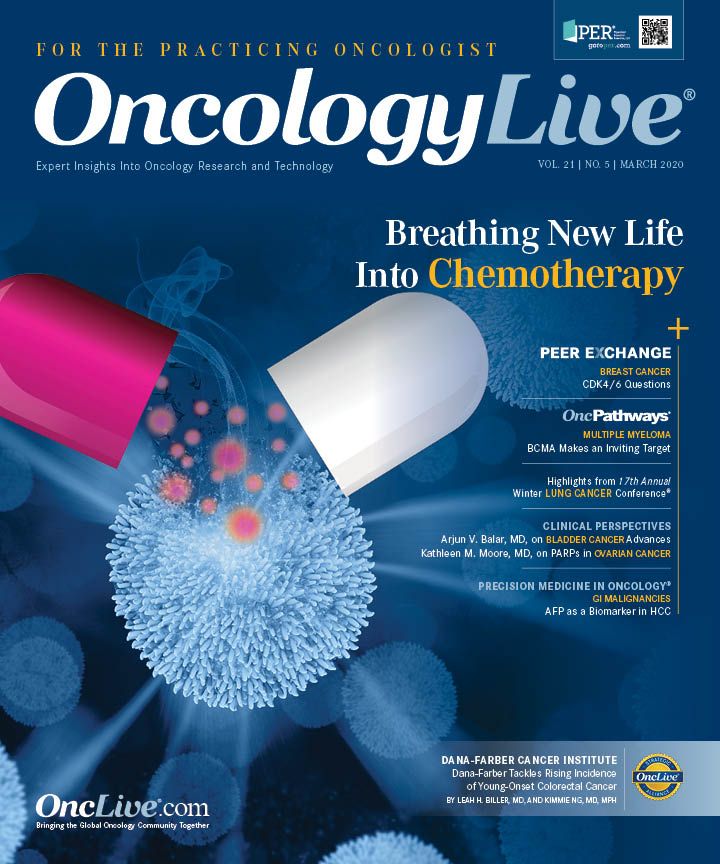First-in-Class ADC Expands Portfolio of Precision Therapies in Bladder Cancer
Bradley McGregor, MD, discusses enfortumab vedotin-ejfv’s path to approval and its future potential in bladder cancer.
Bradley A. McGregor, MD

Bradley A. McGregor, MD
The bladder cancer armamentarium gained a powerful agent in December 2019 with the approval of enfortumab vedotin-ejfv (Padcev), a Nectin-4—directed antibody-drug conjugate (ADC). The agency granted accelerated approval to the firstin- class agent for adults with locally advanced or metastatic urothelial cancer who have previously received a PD-1/PD-L1 inhibitor and a platinum-containing chemotherapy in the neoadjuvant, adjuvant, locally advanced, or metastatic setting. The decision was based on the tumor response rate observed in the phase II single-arm EV-201 trial (NCT03219333).
Enfortumab vedotin “is a new standard of care” for patients whose disease progresses after prior immunotherapy and platinum-based therapy, said Bradley McGregor, MD, an investigator of the EV-201 study, in an interview with OncLive®.
McGregor, a hematologist/oncologist and the clinical director of the Lank Center for Genitourinary Oncology at the Dana-Farber Cancer Institute in Boston, Massachusetts, discussed enfortumab vedotin-ejfv’s path to approval and its future potential in bladder cancer.
OncLive: Please provide an overview of the patient population.
McGregor: Enfortumab vedotin was recently approved based on the phase II EV-201 trial, which was a global, phase II, single-arm study looking at the activity of the agent at a dose of 1.25 mg/kg on days 1, 8, and 15 every 28 days in 2 populations. Cohort A, which is the cohort for which the drug has been approved, looked at patients who had progressed following prior platinum-based therapy as well as immune-checkpoint blockade. Cohort B is ongoing and is exploring the activity of enfortumab vedotin in patients who have progressed solely on immune-checkpoint blockade and have not previously received platinum-based therapy.
Could you discuss the efficacy data that led to the approval?
In urothelial carcinoma, after platinum-based therapy and immune checkpoint blockade, response rates to cytotoxic therapy are pretty poor and average less than 10%. So, our patients have an unmet need. In this trial, the response rate was 44%, which is amazing, and included a 12% [complete response] rate, with a median duration of response approaching 8 months. These data led to the approval of enfortumab vedotin.
Could you describe the mechanism of action?
Enfortumab vedotin is an ADC that targets nectin-4. ADCs are not new to the field of oncology; they’re approved for breast cancer, such as T-DM1 [trastuzumab emtansine; Kadcyla], and in Hodgkin lymphoma, where we have brentuximab vedotin [Adcetris].
In the initial, phase I trials, investigators required expression for nectin-4, but it was quickly realized that nectin-4 is nearly universally expressed in urothelial carcinoma, so this is really a targeted therapy for a universal target.
The ADC attaches to nectin-4—expressing cells, internalizes, and releases MMAE [monomethyl auristatin E] at the site of the cancer.
What do we know about the agent’s tolerability?
We got a lot of information on the toxicity of enfortumab vedotin from EV-201. The most common adverse events were fatigue, neuropathy, hair loss, rash, and changes in appetite and taste. The events that really are of note are the neuropathy, rash, and then, although rare, hyperglycemia. Neuropathy is a known toxicity of MMAE. We see it with brentuximab vedotin as well. Most of these neuropathies resolve to grade 1 or less with a dose hold or dose reduction, so it is important to closely monitor patients while they’re on this therapy for neuropathy.
The rash is a unique toxicity of enfortumab vedotin. It can happen at any time during therapy and often occurs early and is generally treated with topical treatment, most frequently with systemic antihistamines. There is typically little need for a systemic steroid in this situation.
The hypoglycemia is probably a less common adverse event but the one that we need to be on the lookout for most. It is generally not seen in patients who have preexisting diabetes or hypoglycemia, but rather in patients with metabolic syndromes or borderline situations where they receive the drug and [hypoglycemia] presents due to unknown mechanisms of action.
In some instances, it requires an insulin drip, so it is going to be really important to adhere to the guidelines. [For example], hold treatment for over 250 mg/dL blood glucose, but in my experience, it is important to look closely at those patients in the 150 mg/dL to 250 mg/dL range. Is this where they always have been, or is there a change? Is the blood glucose rising to where you need to look at holding enfortumab vedotin?
How does the agent fit into the current treatment paradigm?
Enfortumab vedotin is a new standard of care in those patients who progress post platinum and post immunotherapy, even with this phase II data. Hopefully, as we get more data from cohort B of EV-201, we’ll see activity post immune checkpoint blockade for those patients who are ineligible for platinum-based chemotherapy, and the agent may move into that space as well. But, given the data we have, I think it is a new standard of care for patients who progress on both therapies.
Enfortumab vedotin is certainly a game changer. When you look at patients post platinum or post immunotherapy, there is a subset of patients—about 20%—who have an activating FGFR mutation, which would allow use of erdafitinib [Balversa]. A majority of patients—about 80%—don’t have that mutation, and the historical controls [show that] cytotoxic therapy is not great. So, enfortumab vedotin is also a new standard of care specifically for patients who don’t have an FGFR alteration.
What are the next steps for enfortumab vedotin?
We will await the data from cohort B of EV-201 and the results of the phase III trial that is making a head-to-head comparison of enfortumab vedotin and cytotoxic chemotherapy. The EV-103 trial [NCT03288545], is also ongoing and is looking at combination enfortumab vedotin with multiple agents. At ESMO [European Society of Medical Oncology 2019 Congress], investigators presented data on the combination of enfortumab vedotin and pembrolizumab [Keytruda] on day 1 and day 8 of each 21-day cycle in cisplatin-ineligible patients and saw response rates approaching 71%, which is [strong].
There is also an ongoing phase III trial [EV-301; NCT03474107] looking at enfortumab vedotin versus investigator’s choice of chemotherapy. I certainly think that as we get more experience with the drug, trials will look to move this drug earlier into the treatment paradigm for urothelial carcinoma.
Is there anything else you would like to highlight?
It is a great option for our patients. Of note, we generally think of patients with liver metastases as having very poor prognoses, but in this study [EV-201], even the patients with liver metastases, who are associated with poor responses to systemic therapy, saw a good overall response [38%] from enfortumab vedotin.




